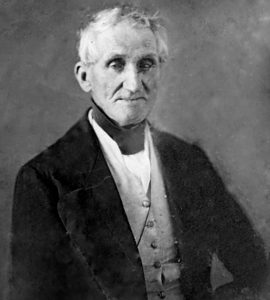 Hugh Brady had a long, distinguished career in the U.S. Army, and for a brief, but critical time in the 1820s, he served in Sault Ste. Marie.
Hugh Brady had a long, distinguished career in the U.S. Army, and for a brief, but critical time in the 1820s, he served in Sault Ste. Marie.
He was born in Pennsylvania in 1768 to John Brady, a Captain in the Revolutionary War, who was killed by Indians. Brady entered the army in 1792 and served with General Wayne in the campaign against the Indians. In 1794 Brady was commissioned Lieutenant and fought in the Battle of Fallen Timbers in Ohio. Soon after being promoted to Captain, Brady was honorably discharged in 1800 and retired to civilian life. He was married in 1805. With the outbreak of the War of 1812, he enlisted in the army with the rank of Colonel. He was in many battles on the Niagara frontier, including the Battle of Lundy’s Lane, where he sustained severe wounds and spent the remainder of the war recuperating. Afterwards, he was stationed at Sackett’s Harbor, New York.
As a result of Governor Lewis Cass’s 1820 treaty with the Chippewa Indians, Colonel Brady was sent to Sault Ste. Marie to establish a fort on the newly acquired land, formerly occupied by the French outpost, Fort Rèpentigny. Colonel Brady, his troops, and Henry Rowe Schoolcraft, Agent of Indian Affairs, arrived in the Sault on July 6, 1822. By November the army had erected a stockade, blockhouses, officers’ quarters, and buildings to house 250 men. While stationed in the Sault, Brady was brevetted Brigadier General in the U.S. Army, in recognition of his ten years of faithful service. The new fort was named after him as was the custom to honor a first commanding officer. Fort Brady remained in use until 1857. In 1866 the second Fort Brady was built, and in 1893 the third one, now Lake Superior State University.
By 1824, General Brady was in command of Fort Howard in Wisconsin and, a year later, he was stationed in Detroit. He was commander of the Northwestern Department of the Army, out of Detroit, beginning in 1835. General Brady was in charge of all the U.S. troops and forts between Detroit and the Mississippi River. He helped resolve frontier troubles with Canada.
Hugh Brady was a tall, genial man of Scotch-Irish ancestry, who was described as a devout and honorable patriot. General Winfield Scott said of Brady, “God never made a better man or a better soldier.†General Brady was honored by his native state in 1840 with the gift of a solid gold sword inlaid with jewels. On May 30, 1848, he was promoted to Major General, for his meritorious conduct. General Brady died on April 15, 1851, after sustaining a fractured skull in a carriage accident. His final words were, “Let the drum beat, my knapsack is slung, I am ready to die.” After an imposing military funeral, he was buried in Detroit’s Elmwood Cemetery at the age of 83.
General Hugh Brady’s name lives on in the Sault in the form of various landmarks: a street, a hill, and the Fort Brady Military Museum at Lake Superior State University.
